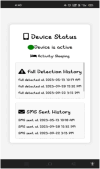Development of artificial intelligence edge computing based wearable device for fall detection and prevention of elderly people
- PMID: 38628753
- PMCID: PMC11019185
- DOI: 10.1016/j.heliyon.2024.e28688
Development of artificial intelligence edge computing based wearable device for fall detection and prevention of elderly people
Abstract
Elderly falls are a major concerning threat resulting in over 1.5-2 million elderly people experiencing severe injuries and 1 million deaths yearly. Falls experienced by Elderly people may lead to a long-term negative impact on their physical and psychological health conditions. Major healthcare research had focused on this lately to detect and prevent the fall. In this work, an Artificial Intelligence (AI) edge computing based wearable device is designed and developed for detection and prevention of fall of elderly people. Further, the various deep learning algorithms such as Convolutional Neural Network (CNN), Recurrent Neural Network (RNN), Long Short-Term Memory (LSTM), Gated Recurrent Unit (GRU) are utilized for activity recognition of elderly. Also, the CNN-LSTM, RNN-LSTM and GRU-LSTM with and without attention layer respectively are utilized and the performance metrics are analyzed to find the best deep learning model. Furthermore, the three different hardware boards such as Jetson Nano developer board, Raspberry PI 3 and 4 are utilized as an AI edge computing device and the best deep learning model is implemented and the computation time is evaluated. Results demonstrate that the CNN-LSTM with attention layer exhibits the accuracy, recall, precision and F1_Score of 97%, 98%, 98% and 0.98 respectively which is better when compared to other deep learning models. Also, the computation time of NVIDIA Jetson Nano is less when compared to other edge computing devices. This work appears to be of high societal relevance since the proposed wearable device can be used to monitor the activity of elderly and prevents the elderly falls which improve the quality of life of elderly people.
Keywords: Accelerometer sensor; Deep learning models; Fall detection; Internet of things; Secure pairing; Wearables.
© 2024 The Authors. Published by Elsevier Ltd.
Conflict of interest statement
The authors declare that they have no known competing financial interests or personal relationships that could have appeared to influence the work reported in this paper.
Figures




















References
-
- Hussain F., Hussain F., Ehatisham-ul-Haq M., Azam M.A. Activity-aware fall detection and recognition based on wearable sensors. IEEE Sensor. J. 2019;19(12):4528–4536.
-
- Cumming R.G., Salkeld G., Thomas M., Szonyi G. Prospective study of the impact of fear of falling on activities of daily living, SF-36 scores, and nursing home admission. The Journals of Gerontology Series A: Biological Sciences and Medical Sciences. 2000;55(5):M299–M305. - PubMed
-
- Scheffer A.C., Schuurmans M.J., Van Dijk N., Van Der Hooft T., De Rooij S.E. Fear of falling: measurement strategy, prevalence, risk factors and consequences among older persons. Age Ageing. 2008;37(1):19–24. - PubMed
LinkOut - more resources
Full Text Sources
Research Materials
Miscellaneous

